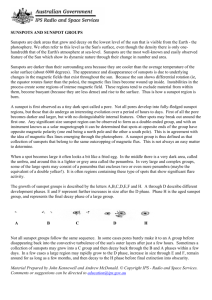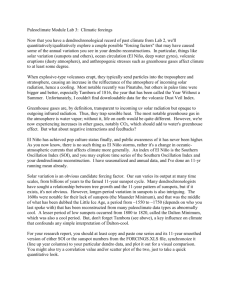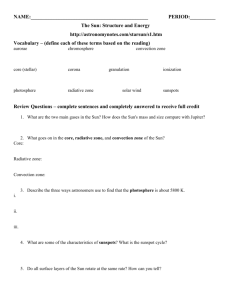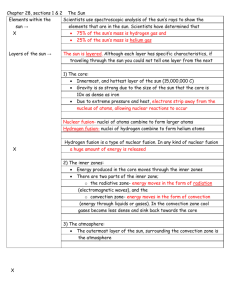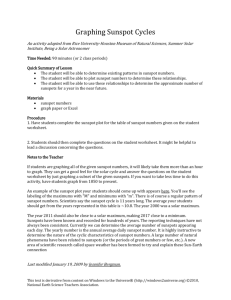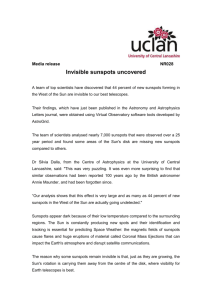Sunspots
advertisement
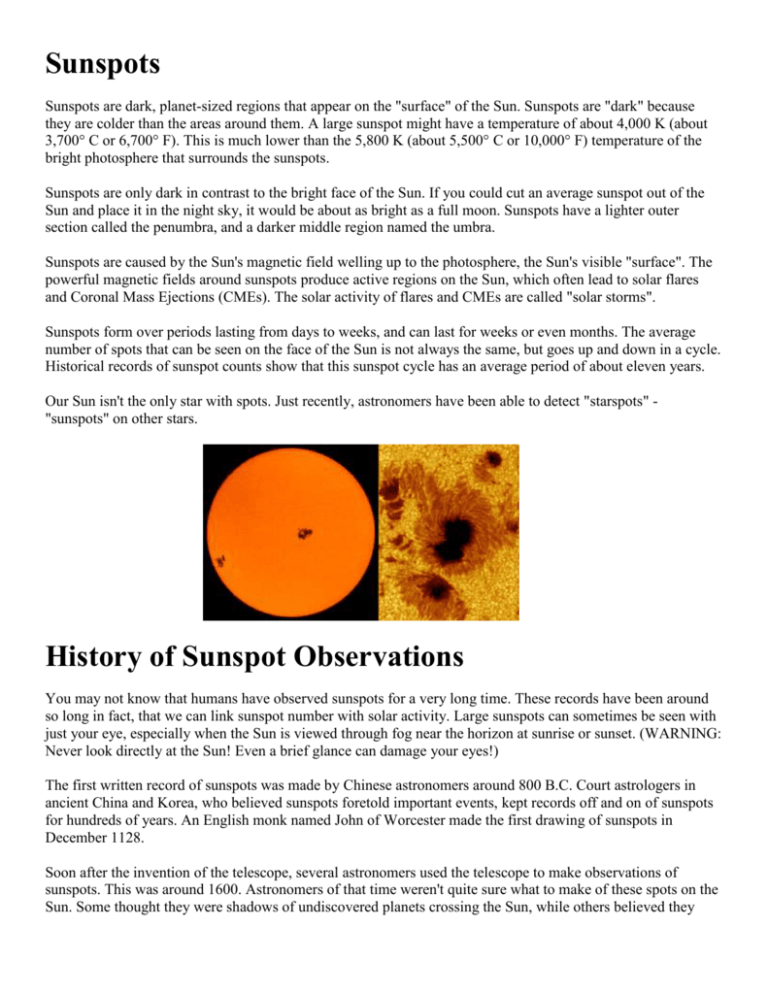
Sunspots Sunspots are dark, planet-sized regions that appear on the "surface" of the Sun. Sunspots are "dark" because they are colder than the areas around them. A large sunspot might have a temperature of about 4,000 K (about 3,700° C or 6,700° F). This is much lower than the 5,800 K (about 5,500° C or 10,000° F) temperature of the bright photosphere that surrounds the sunspots. Sunspots are only dark in contrast to the bright face of the Sun. If you could cut an average sunspot out of the Sun and place it in the night sky, it would be about as bright as a full moon. Sunspots have a lighter outer section called the penumbra, and a darker middle region named the umbra. Sunspots are caused by the Sun's magnetic field welling up to the photosphere, the Sun's visible "surface". The powerful magnetic fields around sunspots produce active regions on the Sun, which often lead to solar flares and Coronal Mass Ejections (CMEs). The solar activity of flares and CMEs are called "solar storms". Sunspots form over periods lasting from days to weeks, and can last for weeks or even months. The average number of spots that can be seen on the face of the Sun is not always the same, but goes up and down in a cycle. Historical records of sunspot counts show that this sunspot cycle has an average period of about eleven years. Our Sun isn't the only star with spots. Just recently, astronomers have been able to detect "starspots" "sunspots" on other stars. History of Sunspot Observations You may not know that humans have observed sunspots for a very long time. These records have been around so long in fact, that we can link sunspot number with solar activity. Large sunspots can sometimes be seen with just your eye, especially when the Sun is viewed through fog near the horizon at sunrise or sunset. (WARNING: Never look directly at the Sun! Even a brief glance can damage your eyes!) The first written record of sunspots was made by Chinese astronomers around 800 B.C. Court astrologers in ancient China and Korea, who believed sunspots foretold important events, kept records off and on of sunspots for hundreds of years. An English monk named John of Worcester made the first drawing of sunspots in December 1128. Soon after the invention of the telescope, several astronomers used the telescope to make observations of sunspots. This was around 1600. Astronomers of that time weren't quite sure what to make of these spots on the Sun. Some thought they were shadows of undiscovered planets crossing the Sun, while others believed they were dark clouds in the Sun's atmosphere. The movement of sunspots across the face of the Sun allowed astronomers in the early 1600's to make the first estimates of the Sun's rotation period (about 27 days). In 1843 an amateur German astronomer named Samuel Schwabe discovered the rise and fall of yearly sunspot counts we now call the sunspot cycle. He first guessed the cycle's length at 10 years. Two French physicists, Louis Fizeau and Léon Foucault, took the first photo of the Sun and sunspots in April 1845. Around 1852 four astronomers noted that the period of the sunspot cycle was identical to the period of changes of geomagnetic activity at Earth, giving birth to the study of Sun-Earth connections we now call "space weather". It would appear that sunspots not only have a connection to geomagnetic activity at Earth, but they play a role in climate change as well. In the last thousands of years, there have been many periods where there were not many sunspots found on the Sun. The most famous is a period from about 1645 to 1715, called the Maunder Minimum. This period corresponds to the middle of a series of exceptionally cold winters throughout Europe known as the Little Ice Age. Scientists still debate whether decreased solar activity helped cause the Little Ice Age, or if the cold snap happen to occur around the same time as the Maunder Minimum. In contrast, a period called the Medieval Maximum, which lasted from 1100 to 1250, apparently had higher levels of sunspots and associated solar activity. This time coincides (at least partially) with a period of warmer climates on Earth called the Medieval Warm Period. Sunspot counts have been higher than usual since around 1900, which has led some scientists to call the time we are in now the Modern Maximum. Sunspot Cycle The number of sunspots seen on the "surface" of the Sun changes from year to year. This rise and fall in sunspot counts is a cycle. The length of the cycle is about eleven years on average. The Sunspot Cycle was discovered in 1843 by the amateur German astronomer Samuel Heinrich Schwabe. A peak in the sunspot count is called "solar maximum" (or "solar max"). The time when few sunspots appear is called a "solar minimum" (or "solar min"). An example of a recent sunspot cycle spans the years from the solar min in 1986, when 13 sunspots were seen, through the solar max in 1989 when more than 157 sunspots appeared, on to the next solar min in 1996 (ten years after the 1986 solar min) when the sunspot count had fallen back down to fewer than 9. The length of the sunspot cycle is, on average, around eleven years. But the length of the cycle does vary. Between 1700 and today, the sunspot cycle (from one solar min to the next solar min) has varied in length from as short as nine years to as long as fourteen years. Sometimes it is hard to get an exact count of number of sunspots on the Sun. Some spots are much bigger than others, some sunspots cross together at their edges, and many spots appear in groups. In 1848, a Swiss astronomer named Rudolf Wolf came up with the best way to count sunspots. The sunspot count using Wolf's formula, now known as the Wolf sunspot number, is still in use today. Wolf used data from earlier astronomers to reconstruct sunspot counts as far back as the 1755-1766 cycle, which he dubbed "cycle 1". Since then, subsequent cycles have been numbered consecutively, so the cycle that began with the 1996 solar minimum is cycle 23. The Sun is usually very active when sunspot counts are high. Sunspots show us where the Sun's magnetic field might be "twisted up" enough to cause solar flares and coronal mass ejections. The Sun gives off more radiation than usual during solar max, and this extra energy changes the uppermost layers of Earth's atmosphere. Questions 1. What are sunspots? 2. Why are sunspots dark? 3. How bright would a sunspot actually look in the night’s sky? 4. What is the average period of a sunspots cycle? 5. When and where was the first written record of a sunspot? 6. Around 1600 what were 2 things that astronomers thought sunspots could be? 7. What is “space weather?” 8. What is the Maunder Minimum? What was going on the sun and on Earth during this time? 9. How many sunspots appeared in 1989? What about 1996? 10. How do we know when the sun is very active? What goes on during these times?
